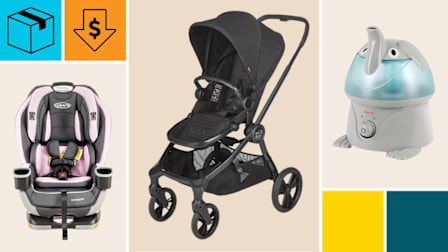Best Baby Gates
Keep your curious baby or toddler safe with gates that excelled in our tests for security
When you shop through retailer links on our site, we may earn affiliate commissions. 100% of the fees we collect are used to support our nonprofit mission. Learn more.

At CR, we’ve put 16 baby gates through rigorous testing, including pulling on each baby gate with up to 100 pounds of force. While we found that permanently mounted gates are strongest, our in-depth ratings can help you find the safety gate right for your specific needs and space.
Baby safety gates, or baby gates, are wall-anchored barricades that cordon off an area or room to keep your child inside a designated space. They’re generally used for children between six months to two years in age, but can also be used to temporarily corral pets, like smaller dogs. Some gates can be used outside, too.
While a gate is no substitute for supervision, it can give you some peace of mind by ensuring your child doesn’t have access to particularly dangerous parts of the home, like rooms with heavy or sharp objects, or stairs.
Best Baby Gates
CR has tested 16 baby safety gates, including two play yards with segments that can be installed as gates. Below are five of the best baby gates from our ratings.
What Makes a Good Baby Gate?
A good baby gate is one that can be set up securely—usually in a doorframe or an open space between two walls—and can keep your child firmly on one side while allowing you to open and pass through it easily.
Whichever you choose, it’s critical to follow the manufacturer’s installation instructions to ensure that the gate performs as designed.
Be wary of secondhand baby gates that may not meet current safety standards. For more information on standards, shopping advice, and what to avoid, check our baby safety gates buying guide.
How CR Tests Baby Gates
We test the baby gates for security, ease of installation, and ease of use.
To test how secure the baby gates are, we use a digital force gauge to measure their ability to withstand lateral forces (the gate’s resistance to opening or collapsing when someone or something pulls or pushes it). We install the gate in a doorway, close it, and attach a force gauge hook that is pulled until the gate opens or the force equals 100 pounds. (As of July 2021, gates certified by the Juvenile Products Manufacturers Association must withstand 30 pounds of force before dislodging.)
CR also rates safety gates for ease of installation—how complex the directions are and how much work it involves—and for ease of use: We assess how convenient it is to open the gate and pass through, and note whether or not it can be opened one-handed.
@consumerreports The Bugaboo Giraffe high chair has been recalled after 13 injuries were reported. The recall comes one day after we urged the Consumer Product Safety Commission (CPSC) to do an investigation and recall. Tap the link in our bio to learn what to do if you own one. #babytok #bugaboogiraffe #highchairs #highchairsafety #babysafety
♬ original sound - Consumer Reports - Consumer Reports

































